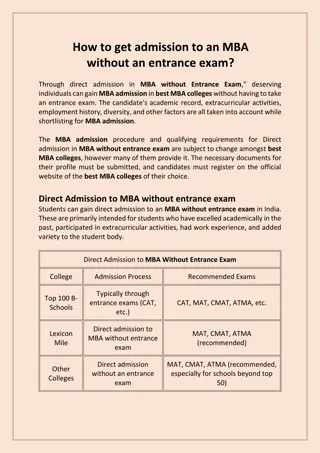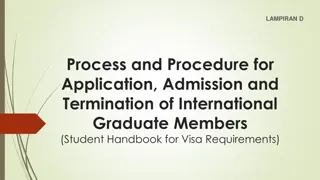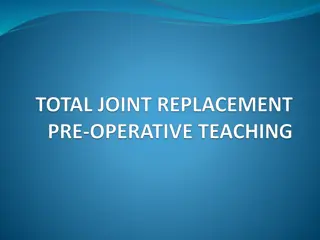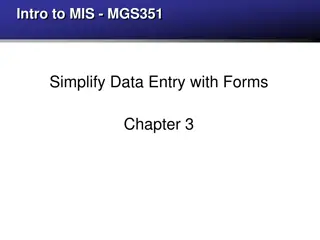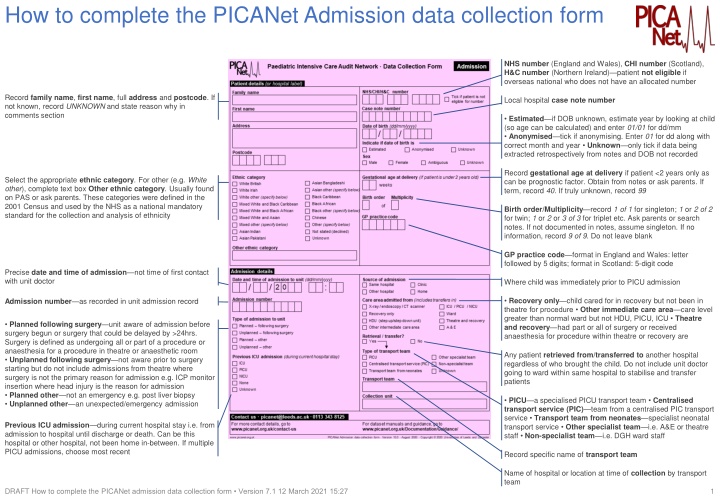
Complete PICANet Admission Data Collection Form Guidance
Learn how to accurately complete the PICANet Admission Data Collection Form, including recording patient details, admission information, and medical data. Ensure compliance with NHS guidelines for data collection and analysis. Follow step-by-step instructions to fill in essential fields like NHS/CHI/H&C numbers, patient demographics, hospital case notes, and more.
Download Presentation

Please find below an Image/Link to download the presentation.
The content on the website is provided AS IS for your information and personal use only. It may not be sold, licensed, or shared on other websites without obtaining consent from the author. If you encounter any issues during the download, it is possible that the publisher has removed the file from their server.
You are allowed to download the files provided on this website for personal or commercial use, subject to the condition that they are used lawfully. All files are the property of their respective owners.
The content on the website is provided AS IS for your information and personal use only. It may not be sold, licensed, or shared on other websites without obtaining consent from the author.
E N D
Presentation Transcript
How to complete the PICANet Admission data collection form NHS number (England and Wales), CHI number (Scotland), H&C number (Northern Ireland) patient not eligible if overseas national who does not have an allocated number Record family name, first name, full address and postcode. If not known, record UNKNOWN and state reason why in comments section Local hospital case note number Estimated if DOB unknown, estimate year by looking at child (so age can be calculated) and enter 01/01 for dd/mm Anonymised tick if anonymising. Enter 01 for dd along with correct month and year Unknown only tick if data being extracted retrospectively from notes and DOB not recorded Record gestational age at delivery if patient <2 years only as can be prognostic factor. Obtain from notes or ask parents. If term, record 40. If truly unknown, record 99 Select the appropriate ethnic category. For other (e.g. White other), complete text box Other ethnic category. Usually found on PAS or ask parents. These categories were defined in the 2001 Census and used by the NHS as a national mandatory standard for the collection and analysis of ethnicity Birth order/Multiplicity record 1 of 1 for singleton; 1 or 2 of 2 for twin; 1 or 2 or 3of 3 for triplet etc. Ask parents or search notes. If not documented in notes, assume singleton. If no information, record 9 of 9. Do not leave blank GP practice code format in England and Wales: letter followed by 5 digits; format in Scotland: 5-digit code Precise date and time of admission not time of first contact with unit doctor Where child was immediately prior to PICU admission Recovery only child cared for in recovery but not been in theatre for procedure Other immediate care area care level greater than normal ward but not HDU, PICU, ICU Theatre and recovery had part or all of surgery or received anaesthesia for procedure within theatre or recovery are Admission number as recorded in unit admission record Planned following surgery unit aware of admission before surgery begun or surgery that could be delayed by >24hrs. Surgery is defined as undergoing all or part of a procedure or anaesthesia for a procedure in theatre or anaesthetic room Unplanned following surgery not aware prior to surgery starting but do not include admissions from theatre where surgery is not the primary reason for admission e.g. ICP monitor insertion where head injury is the reason for admission Planned other not an emergency e.g. post liver biopsy Unplanned other an unexpected/emergency admission Any patient retrieved from/transferred to another hospital regardless of who brought the child. Do not include unit doctor going to ward within same hospital to stabilise and transfer patients PICU a specialised PICU transport team Centralised transport service (PIC) team from a centralised PIC transport service Transport team from neonates specialist neonatal transport service Other specialist team i.e. A&E or theatre staff Non-specialist team i.e. DGH ward staff Previous ICU admission during current hospital stay i.e. from admission to hospital until discharge or death. Can be this hospital or other hospital, not been home in-between. If multiple PICU admissions, choose most recent Record specific name of transport team Name of hospital or location at time of collection by transport team DRAFT How to complete the PICANet admission data collection form Version 7.1 12 March 2021 15:27 1
First systolic blood pressure recorded within defined time period. Record 0 if patient in cardiac arrest, or 30 if patient shocked and BP is measured but not recordable. If not measured, enter 999 Elective admission i.e. after elective surgery/procedure or for monitoring. Consider elective if could be postponed for >6hrs without adverse effects. Note: Elective admission for PIM purposes differs from a planned admission following surgery, which is defined as the unit being aware of the admission prior to surgery or that the surgery could have been delayed for >24hrs Record the first SpO2 and corresponding FiO2 measured following first face-to-face contact between the patient and a PIC doctor Tick if blood gas samples (arterial, capillary or venous) were taken and recorded within the defined time period Main reason for PICU admission evidence available at the time of the admission event from notes, GP or family. Not including new diagnosis during this PICU admission event. If recovery from surgery, select type of procedure First arterial PaO2 measured and recorded at first contact between the patient and a specialist PIC doctor. Do not document if venous or capillary gases. If missing, record 999 FiO2 recorded at time of first arterial gas. If arterial gas not recorded write 999 Cardiac arrest before ICU admission documented absence of pulse or requirement for external cardiac compression before this admission to paediatric intensive care service. Not past history of cardiac arrest Cardiomyopathy or myocarditis documented diagnosis during 1 month period before or at contact with unit doctor. Not if develops after admission. Not including children with impaired cardiac function due to sepsis or surgery. ECHO findings of endocardial fibroelastosis plus poor ventricular function are sufficient not just poor function Severe combined immune deficiency documented at or prior to admission. Tick even if had successful bone marrow transplant Hypoplastic left heart syndrome including those with previous successful surgical repair. Not hypoplastic left ventricle unless documented ventriculo-arterial concordance Leukaemia/lymphoma after first induction irrespective of state of immunity or remission Liver failure includes patients recovering from liver transplant for acute or chronic liver failure Acute NEC prior to or at first contact with PIC service Spontaneous cerebral haemorrhage e.g. aneurysm, associated with need for admission. Not intracranial bleeds as a result of trauma Neurodegenerative disorder progressive deterioration with loss of speech, vision, hearing, locomotion. Not static disability even if severe, unless progressive loss of milestones HIV antigen positive Bone marrow transplant recipient during this hospital admission Tick if intubated at time of arterial gas. Includes endotracheal tube, LMA and tracheostomy First base excess from arterial, capillary or venous gas within defined time period. If not or never recorded, write 999. Indicate ve or +ve and specify sample type First blood lactate from arterial, capillary or venous gas within defined time period. Specify sample type Mechanical ventilation where all or some of the breaths, or portion of the breaths (pressure support) are delivered by a mechanical device. Includes high frequency, jet ventilators, negative pressure ventilators, BIPAP & CPAP CPAP includes via ET, mask, nasal prongs or negative pressure. Do not include high flow nasal cannula therapy First pupillary reaction measured AND recorded within defined time period Both fixed and dilated if both >3mm and both unreactive to light Primary diagnosis for this admission can only choose one diagnosis and must be a disorder/condition May confirm at end of admission Not a procedure e.g. hernia repair or cause e.g. apnoea must be the underlying condition Other reasons for this admission includes additional diagnoses or procedures that may or may not have required intensive care e.g. partially obstructed airway Operations or procedures performed during and prior to this admission e.g. scoliosis repair, lung biopsy. Where type of admission is planned or unplanned following surgery, at least one operation or procedure is required Co-morbidity diagnoses child has prior to admission that may not be related to reason for this admission. Any underlying conditions e.g. syndromes Tracheostomy performed during this admission do not include those done prior to this admission where tracheostomy insertion is the reason for admission. Complete at discharge 2 DRAFT How to complete the PICANet admission data collection form Version 7.1 12 March 2021 15:27
Daily interventionsrecord admission date and insert X in box for each intervention given at any time in each 24-hour period from midnight to midnight. If no interventions given choose No defined critical care activity (i.e. no other interventions recorded) to signify daily intervention record completed for identified day of stay High flow nasal cannula therapy (HFNCT) record maximum flow in L/min that day Record the number of unplanned extubations that day, defined as the dislodgement of the ETT from the trachea without the intention to extubate immediately and without the presence of airway competent clinical staff in the bedspace appropriately prepared for the procedure Patient nursed in single occupancy cubicle record X in box and state reason for isolation in text box below 3 DRAFT How to complete the PICANet admission data collection form Version 7.1 12 March 2021 15:27
Status at 30 days post-dischargecomplete for all PICU discharges. If cannot find out, record Unknown Is the patient on a clinical trial check the hospital notes or ask the parents, as if on a trial this could affect prognosis. Includes clinical trials outside PICU Location at 30 days post-discharge information found by using hospital record systems, contacting ward, GP, medical records, NOT directly calling family Completion of weight is now mandatory as part of the core admission dataset. Record weight in kilograms measured at or as soon as possible after admission to the unit. If this is not possible then a weight measured immediately prior to transfer to PICU or provided by parent/carer may be recorded Discharge as recorded in unit admission book. Physical discharge and recording of discharge from bed or cot. Discharge does not include temporary transfer (e.g. to theatre for surgery) when there is expectation of a return to your unit Discharged for palliative care signifies withdrawal of care at the current level from which it is deemed the admission can no longer benefit Date and time of death if death occurs while on unit and/or prior to discharge, even if patient not physically present on the unit at the time e.g. in theatre. Include those who leave the unit to become beating heart donors. If time of death is prior to admission, add note in comments box and inform PICANet by separate email Treatment withdrawn death follows the withdrawal of ongoing organ support Treatment limitation death follows a decision to limit on-going organ support and may include limitation of support and/or the patient is not for active resuscitation Brain stem death death confirmed using brain stem death criteria Failed cardiopulmonary resuscitation death immediately follows an unsuccessful attempt at CPR Identifies whether the deceased patient was a transplant donor and whether solid organs and/or tissues were removed for transplant. Organs may include heart, pancreas, liver, kidneys, or intestines. Tissues may include skin, tendons, bone, heart valves and cornea For additional information, see the PICANet admission dataset manual, available at www.picanet.org.uk 4 DRAFT How to complete the PICANet admission data collection form Version 7.1 12 March 2021 15:27















